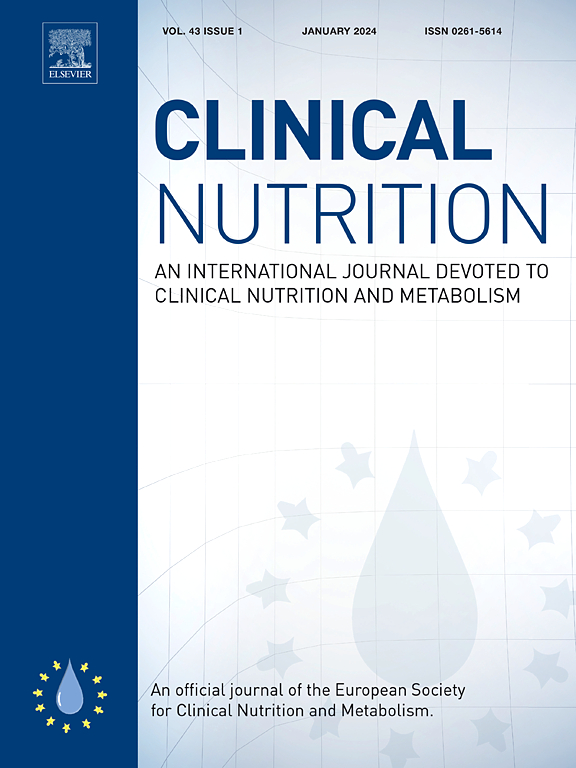传统地中海饮食与超加工食品消费的结合与全因和特定原因死亡率的关系:Moli-sani研究的前瞻性发现
IF 6.6
2区 医学
Q1 NUTRITION & DIETETICS
引用次数: 0
摘要
背景,目的超加工食品(upf)正日益取代传统饮食,对健康造成威胁。因此,我们旨在研究意大利成年人中坚持传统地中海饮食(MD)和超加工食品(UPF)消费的不同组合与全因和特定原因死亡率之间的关系。方法前瞻性分析22939名男性和女性(平均年龄55±12岁)随访15.0年(中位)的资料。食物摄取量由188项FFQ评估。UPF是根据Nova分类定义的,并以权重比计算。地中海饮食评分;范围0-9)用于评估MD依从性。低/高MD依从性(即MDS <;6或≥6)与低/高UPF消耗(即<;9.4或≥9.4,即人群中位摄入量)相结合,获得4级饮食变量,导致以下饮食组合:1)低MD/高UPF;2)高MD/高UPF;3)低MD/低UPF;4)高MD/低UPF。结果与低MD/高UPF类别相比,高度坚持传统MD结合低UPF消费成为降低全因死亡风险的最佳饮食模式(HR = 0.76;95%CI 0.68-0.85),以及心血管(HR = 0.80;95%CI 0.67-0.96)和非心血管/非癌症死亡率(HR = 0.57;95%可信区间0.47 - -0.70)。这两种饮食因素在缺血性心脏病(IHD)/脑血管和非心血管/非癌症死亡率结果中观察到相互作用(相乘相互作用的p值分别为0.050和0.0011),表明这两种饮食因素协同作用。没有发现与癌症相关的死亡率有关。结论:在一项大型意大利成年队列研究中,高度坚持传统饮食并低摄入upf是提高生存率和降低非癌症相关死亡率的最佳饮食组合。饮食指南应强调减少UPF摄入的重要性,同时遵循每日摄入量,以充分发挥其健康益处。本文章由计算机程序翻译,如有差异,请以英文原文为准。
Combination of a traditional Mediterranean Diet with ultra-processed food consumption in relation to all-cause and cause-specific mortality: Prospective findings from the Moli-sani Study
Background & aims
Ultra-processed foods (UPFs) are increasingly displacing traditional diets with threatening health impacts. We therefore aimed to examine the association between different combinations of adherence to a traditional Mediterranean Diet (MD) and ultra-processed food (UPF) consumption with all-cause and cause-specific mortality amongst adult Italians.
Methods
We prospectively analysed data from 22,939 men and women (mean age 55 ± 12 years) followed for 15.0 years (median). Food intake was assessed by a 188-item FFQ. UPF was defined following the Nova classification and calculated as a weight ratio. The Mediterranean Diet Score (MDS; range 0–9) was used to assess adherence to MD. Low/High MD adherence (i.e. MDS <6 or ≥6, respectively) was combined with low/high UPF consumption (i.e. <9.4 or ≥9.4, i.e. population median intake) to obtain a 4-level dietary variable resulting in the following dietary combinations: 1) low MD/high UPF; 2) High MD/high UPF; 3) Low MD/low UPF; and 4) High MD/low UPF.
Results
When compared to the low MD/high UPF category, a high adherence to a traditional MD combined with low UPF consumption emerged as the optimal dietary pattern for reducing the risk of all-cause mortality (HR = 0.76; 95%CI 0.68–0.85), as well as cardiovascular (HR = 0.80; 95%CI 0.67–0.96) and non-cardiovascular/non-cancer mortality (HR = 0.57; 95%CI 0.47–0.70). An interaction between these two dietary factors was observed for ischemic heart disease (IHD)/cerebrovascular and non-cardiovascular/non-cancer mortality outcomes (p values for multiplicative interaction = 0.050 and 0.0011, respectively), indicating that these two dietary factors work synergistically. No association was found with cancer-related mortality.
Conclusions
In a large cohort of adult Italians, a high adherence to a traditional MD combined with low consumption of UPFs was the optimal dietary combination for improved survival rates and lower non-cancer-related mortality. Dietary guidelines should emphasize the importance of reducing UPF consumption alongside following an MD to fully maximize its health benefits.
求助全文
通过发布文献求助,成功后即可免费获取论文全文。
去求助
来源期刊

Clinical nutrition
医学-营养学
CiteScore
14.10
自引率
6.30%
发文量
356
审稿时长
28 days
期刊介绍:
Clinical Nutrition, the official journal of ESPEN, The European Society for Clinical Nutrition and Metabolism, is an international journal providing essential scientific information on nutritional and metabolic care and the relationship between nutrition and disease both in the setting of basic science and clinical practice. Published bi-monthly, each issue combines original articles and reviews providing an invaluable reference for any specialist concerned with these fields.
 求助内容:
求助内容: 应助结果提醒方式:
应助结果提醒方式:


